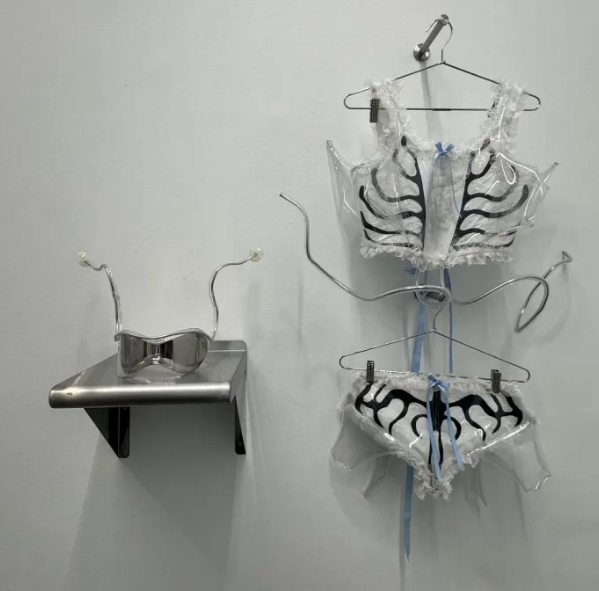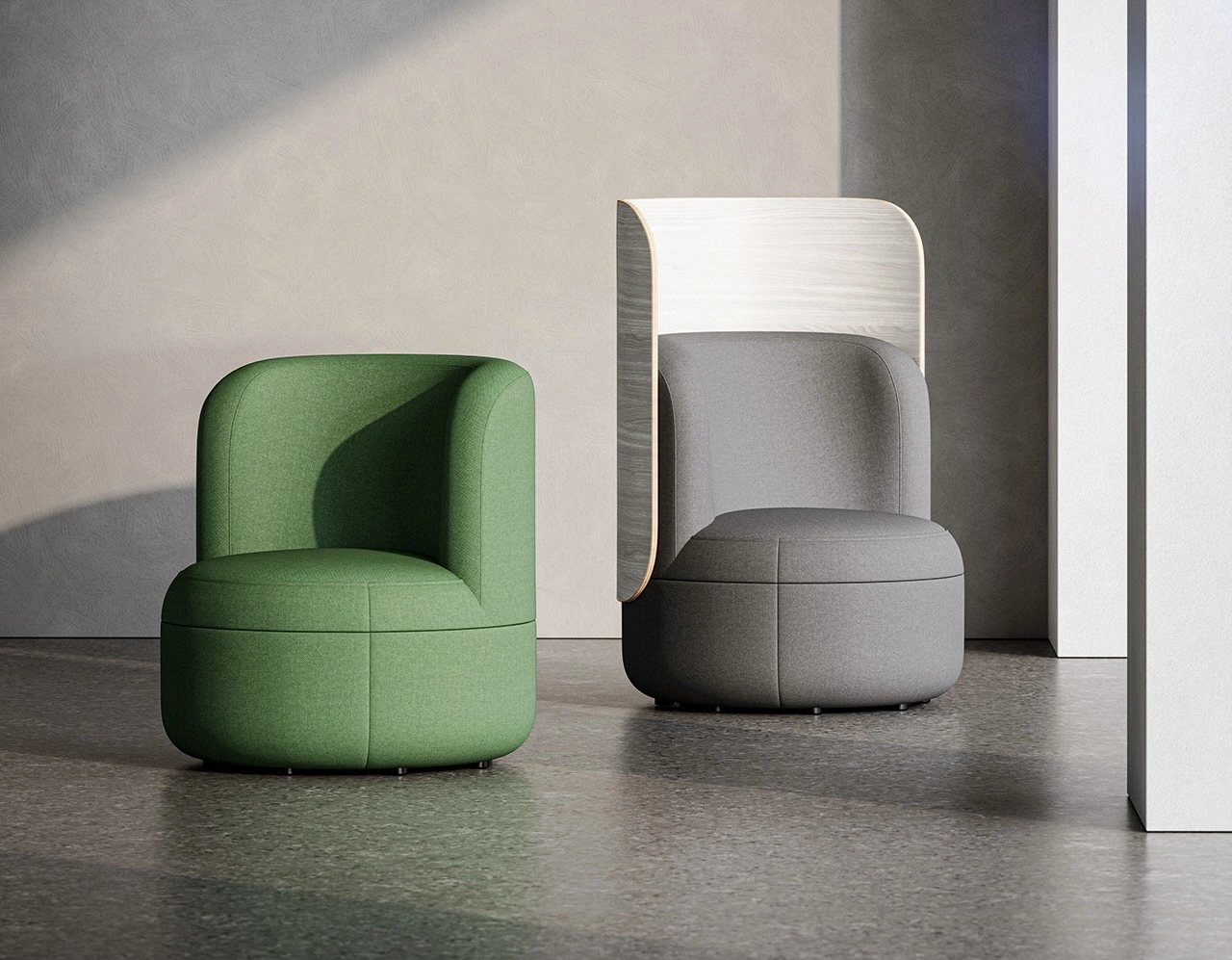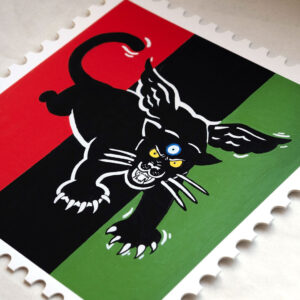Photo Credit: Daniel Larkin / Hyperallergic
The gallery wall, once a neutral host of static declarations, now trembles with the charged presence of Lizzy Choi’s Ctenophora (2025), an anatomical rebuke to centuries of body discipline. Corset, briefs, and antennaed sunglasses—each component rendered in synthetic clarity and comb-like curvature—float in suspension, hung on wiry, quasi-organic armatures. If the white cube has long insisted on neutrality, Choi’s work pierces it with the bioluminescent pulse of embodiment, of protest, and of gendered transcendence. Named after the comb jellyfish, a marine animal renowned for its ethereal, ciliated glow, Ctenophora refracts identity through the aqueous logic of fluidity and resistance.
Displayed at New York University’s MFA Thesis Show: Part II, the piece signifies a confluence of sculpture, fashion, biology, and queer theory—a wearable mythos challenging not only what bodies wear but how bodies are read. The “underwear” of Ctenophora does not hide or titillate. It confronts. It pulses with implication. This is not lingerie—it is liturgy.
Anatomy of a Jellyfish: Constructing the Wearable Form
At first glance, Choi’s Ctenophora appears like a sci-fi ensemble for a posthuman cabaret: clear vinyl trimmed with white lace; thick black curvilinear piping mimicking the muscular architecture of marine creatures; a wash of innocence betrayed by the glint of aggression. The corset, translucent and ribbed, does not constrain so much as pronounce. Paired with briefs bearing matching motifs and antennaed glasses perched like an alien exoskeleton, the set invokes anatomy as costume, as performance, as confrontation.
The piece borrows heavily from the biological forms of ctenophores, creatures known not just for their aesthetic wonder but for their strange, non-binary biology. With their comb-like rows of cilia and their capacity for both bioluminescence and self-fertilization, ctenophores offer an alternative to anthropocentric, binaristic gender frameworks. Choi renders this reference not as metaphor but as blueprint—reconfiguring human wearability to align with a creature untethered from our rigid taxonomies.
The materiality itself—a combination of sheer plastics, ruffles, and rigid tubing—resonates with both delicacy and defense. There is beauty here, but it is not submissive. It is armored intimacy, eroticism divorced from objectification. The body it imagines is not offered for consumption—it is barricaded, charged, bioluminescent in refusal.
The Politics of Lingerie: From Confinement to Command
Lingerie, historically, is a site of tension: a garment worn beneath, constructed to shape, entice, and discipline. It is both secret and spectacle. In Ctenophora, Choi pulls lingerie out from beneath—upending its traditional secrecy and placing it on the wall, in plain sight, as object and subject alike.
The corset, in particular, becomes a loaded form. From Victorian waist training to 20th-century sexual liberation to Gen Z’s Y2K revival, the corset has moved between oppression and empowerment. Yet Choi’s iteration neither cinches nor seduces. Instead, it subverts. The lace is present, yes—but paired with sculptural vertebrae. The softness of the ruffle is undone by the sharp assertiveness of the bone-black ridges.
Critically, the inclusion of antennaed eyewear takes the piece out of a purely bodily space and into an inter-species imaginary. With silver rods stretching from the glasses like insect appendages, Choi reclaims vision itself. To look and to be looked at is recoded; now, the wearer is both observer and invader. Surveillance becomes mutation.
Queering Form: The Body as Plural and Becoming
Choi’s sculptural wearables participate in what theorist Paul Preciado might call “techno-queer assemblage”—an approach that refuses the fixity of binary anatomy in favor of mutation, prosthesis, and posthuman design. Ctenophora does not suggest a fixed identity but rather a performance of becoming, a state of constant iridescent transformation.
This queer embodiment is not abstract. It emerges through the act of wearing, the deliberate queering of lingerie’s historical role. Choi’s statement piece is not just visual commentary—it is a prosthetic for defiance. Just as ctenophores float through their marine environment, transforming their hue in response to stimuli, the wearer of Ctenophora is similarly imagined as shifting, fluid, glowing beneath scrutiny but never surrendering to it.
The bio-anatomical structures are literal: the black tendrils resemble spinal traces, the shapes of lungs, or muscle fibers. But they also resemble branches, coral, or root systems—suggesting a body connected not just to gender but to ecological identity. It is a vision of queerness embedded in interdependence, rather than isolation.
Performance as Reclamation
Though displayed on the wall like a relic or shrine, Ctenophora has lived beyond stillness. At the NYU MFA show’s opening, the piece was performed—worn by a model whose presence reactivated the work’s function. This performance element reveals the ultimate defiance within Choi’s work: that clothing can be weaponized not through violence, but through performance, through presence, through spectacle reclaimed on one’s own terms.
The body, once made vulnerable by exposure, becomes armored through choreography. The model, inhabiting this comb-jelly exosuit, radiates not sexuality but sovereignty. This is not drag in the traditional sense, nor mere fashion show—it is gender spectacle as resistance, a sci-fi ritual staged within the pristine realm of contemporary art. It is Lizzy Choi’s answer to patriarchal definition: something that slips, flashes, glows, and leaves no binary untouched.
Beyond the Gallery: Lizzy Choi’s Expanding Ecosystem
Ctenophora is not an anomaly in Choi’s practice. The artist—originally from Sacramento and currently an MFA candidate at NYU Steinhardt—has consistently blended sculpture, performance, and eroticism to stage acts of bodily insurgency. In their 2025 performance piece Shedding, co-performed with Lily Hyon, Choi explores gender as metamorphosis, describing the act as “a striptease, copulation, friendship, mitosis, bursting, rebirth, insectuous act.” The language here is not incidental—it reinforces Choi’s vision of the body as an unstable compound, capable of constant molting.
Choi’s work reclaims not just identity, but biology itself as a poetic terrain. Where traditional science seeks to categorize, Choi seeks to dissolve. Where fashion polices fit and flattery, Choi distorts, exaggerates, and reanimates. Their wearable sculptures propose new species of femininity, masculinity, and in-betweenness—species that don’t adhere to terrestrial logic.
Toward a Bioluminescent Feminism
In Ctenophora, Lizzy Choi offers more than a garment, more than a provocation. They offer a framework: a luminous, comb-ribbed thesis on what it means to live in a body that refuses categorization. Like its marine namesake, the piece pulses with the friction between attraction and unease, visibility and opacity, beauty and threat. It is, in every sense, a queer ecology—an embodiment not of stasis, but of slippage, reflection, and multiplicity.
As fashion becomes increasingly folded into the art world—no longer dismissed as “mere clothes,” but recognized as tools for identity-making and socio-political critique—Ctenophora reminds us that the stakes of what we wear are, and have always been, existential. Choi’s work does not just imagine another body. It imagines another world—a world in which fluidity is not feared but revered.
No comments yet.








